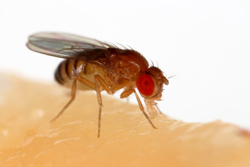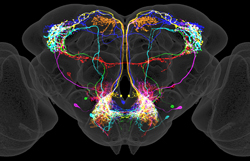Projects
Feeding motor sequences
 How do neural circuits coordinate the activity of multiple motor neurons to produce complex behaviors? The feeding initiation circuit in Drosophila melanogaster is uniquely suited to exploring this question because the sensory inputs, motor outputs, and the basic circuit that connects them have already been described. Feeding initiation requires the coordinated movement of the four proboscis segments. To describe the essential feeding initiation circuit, we focused on a single motor neuron that is required for feeding as a simple proxy for proboscis extension. However, proboscis movement is a complex motor action that requires the coordinated activity of 16 identified motor neurons. We will investigate how the feeding initiation circuit orchestrates the activity of multiple motor neurons, revealing general and fundamental principles about how motor sequences are generated by neural circuits.
How do neural circuits coordinate the activity of multiple motor neurons to produce complex behaviors? The feeding initiation circuit in Drosophila melanogaster is uniquely suited to exploring this question because the sensory inputs, motor outputs, and the basic circuit that connects them have already been described. Feeding initiation requires the coordinated movement of the four proboscis segments. To describe the essential feeding initiation circuit, we focused on a single motor neuron that is required for feeding as a simple proxy for proboscis extension. However, proboscis movement is a complex motor action that requires the coordinated activity of 16 identified motor neurons. We will investigate how the feeding initiation circuit orchestrates the activity of multiple motor neurons, revealing general and fundamental principles about how motor sequences are generated by neural circuits.
Feeding microstructure
 How are feeding behaviors properly timed? To balance food intake with energy needs, the interval between meals must be tightly regulated. During meals, interval timing is also required to generate rhythmic behaviors like licking, swallowing, and pumping. What are the circuit-level coding strategies that produce feeding rhythms across these disparate timescales? Advances in automated, high-resolution monitoring of Drosophila melanogaster feeding now allow detailed quantification of feeding microstructure. These experiments reveal that flies feed in bursts (meals) composed of many, evenly spaced sips. Though the inter-burst interval and the number of sips per burst are altered by hunger, the inter-sip interval is affected not by hunger but by food composition. We will investigate how the activity of the feeding initiation circuit is controlled across multiple timescales to reveal general circuit motifs that shape behavioral rhythms.
How are feeding behaviors properly timed? To balance food intake with energy needs, the interval between meals must be tightly regulated. During meals, interval timing is also required to generate rhythmic behaviors like licking, swallowing, and pumping. What are the circuit-level coding strategies that produce feeding rhythms across these disparate timescales? Advances in automated, high-resolution monitoring of Drosophila melanogaster feeding now allow detailed quantification of feeding microstructure. These experiments reveal that flies feed in bursts (meals) composed of many, evenly spaced sips. Though the inter-burst interval and the number of sips per burst are altered by hunger, the inter-sip interval is affected not by hunger but by food composition. We will investigate how the activity of the feeding initiation circuit is controlled across multiple timescales to reveal general circuit motifs that shape behavioral rhythms.
Feeding memories
 How are feeding experiences remembered? To meet their physiological requirements in mutable environments, animals must form feeding memories and use them to select context-appropriate behaviors. What are the circuit mechanisms that represent distinct feeding experiences to generate context-specific memories? In gustatory associative learning, flies alter their response to taste information after experiencing an innately aversive stimulus. This task requires well characterized circuits in the mushroom body, a critical higher brain region for experiential learning. We will investigate the neural pathways and coding strategies that convey information about feeding experiences to higher brain memory circuits during gustatory associative learning. These studies will reveal circuit architectures for taste processing that will facilitate the study of more complex systems and inform the design of artificial neural networks.
How are feeding experiences remembered? To meet their physiological requirements in mutable environments, animals must form feeding memories and use them to select context-appropriate behaviors. What are the circuit mechanisms that represent distinct feeding experiences to generate context-specific memories? In gustatory associative learning, flies alter their response to taste information after experiencing an innately aversive stimulus. This task requires well characterized circuits in the mushroom body, a critical higher brain region for experiential learning. We will investigate the neural pathways and coding strategies that convey information about feeding experiences to higher brain memory circuits during gustatory associative learning. These studies will reveal circuit architectures for taste processing that will facilitate the study of more complex systems and inform the design of artificial neural networks.